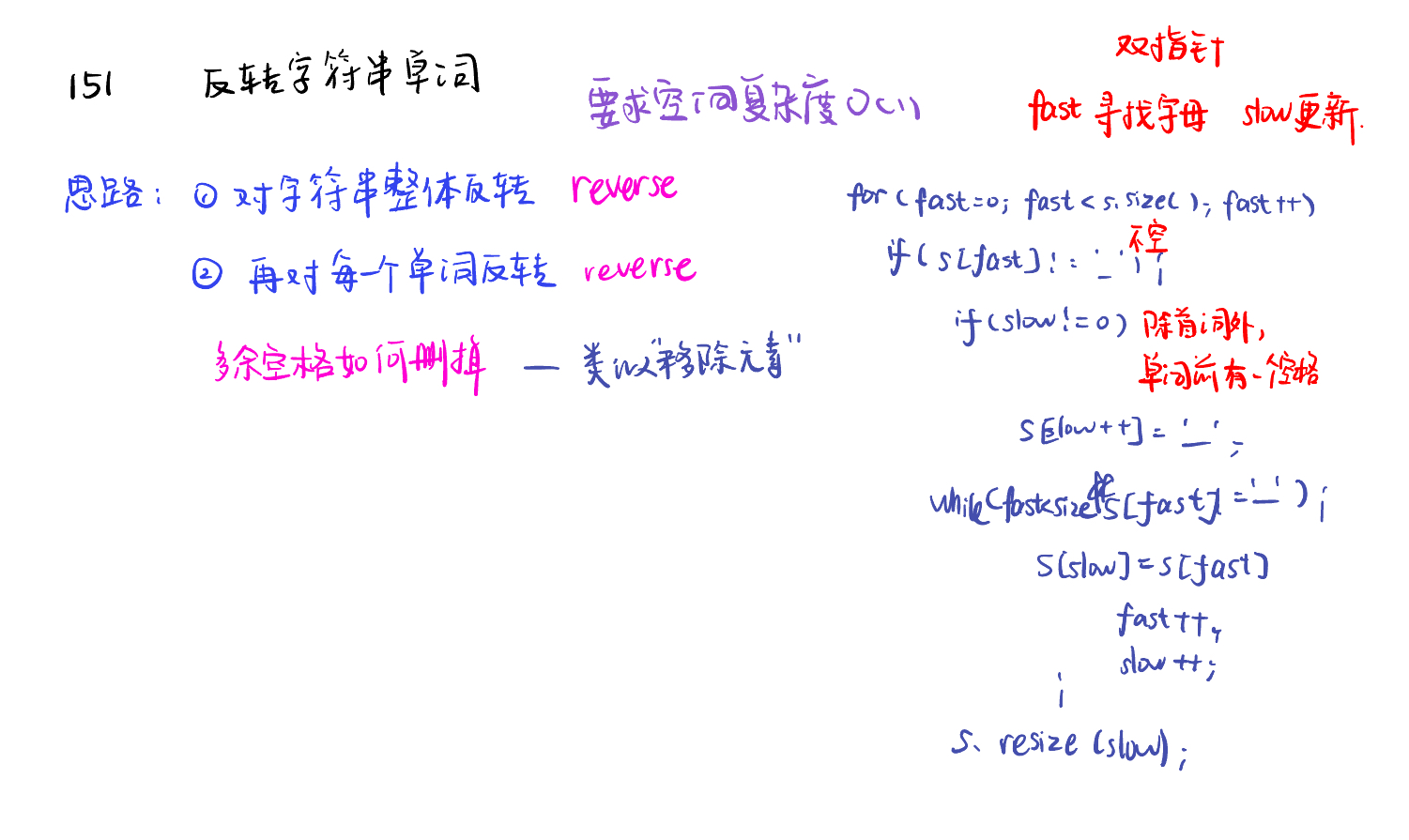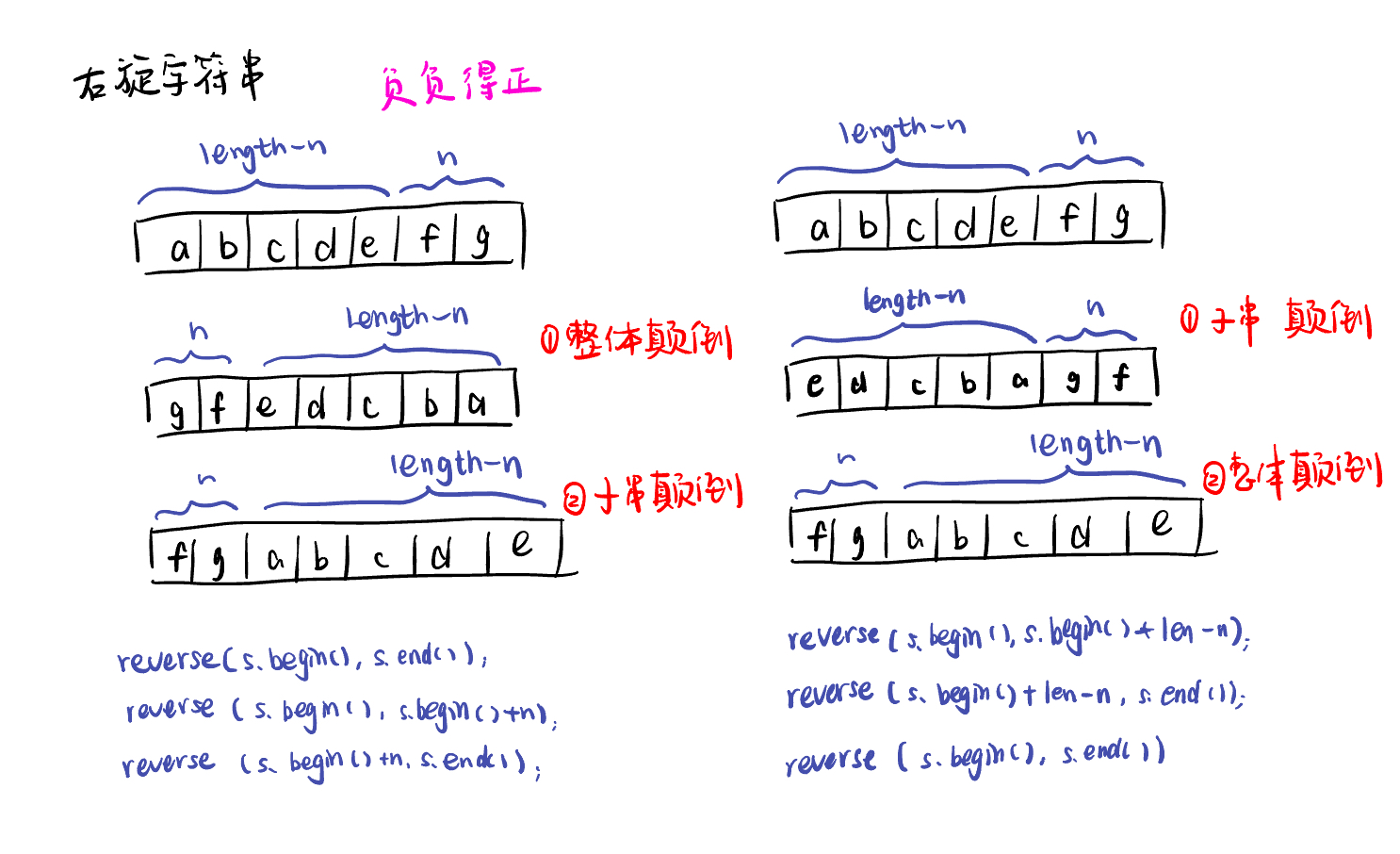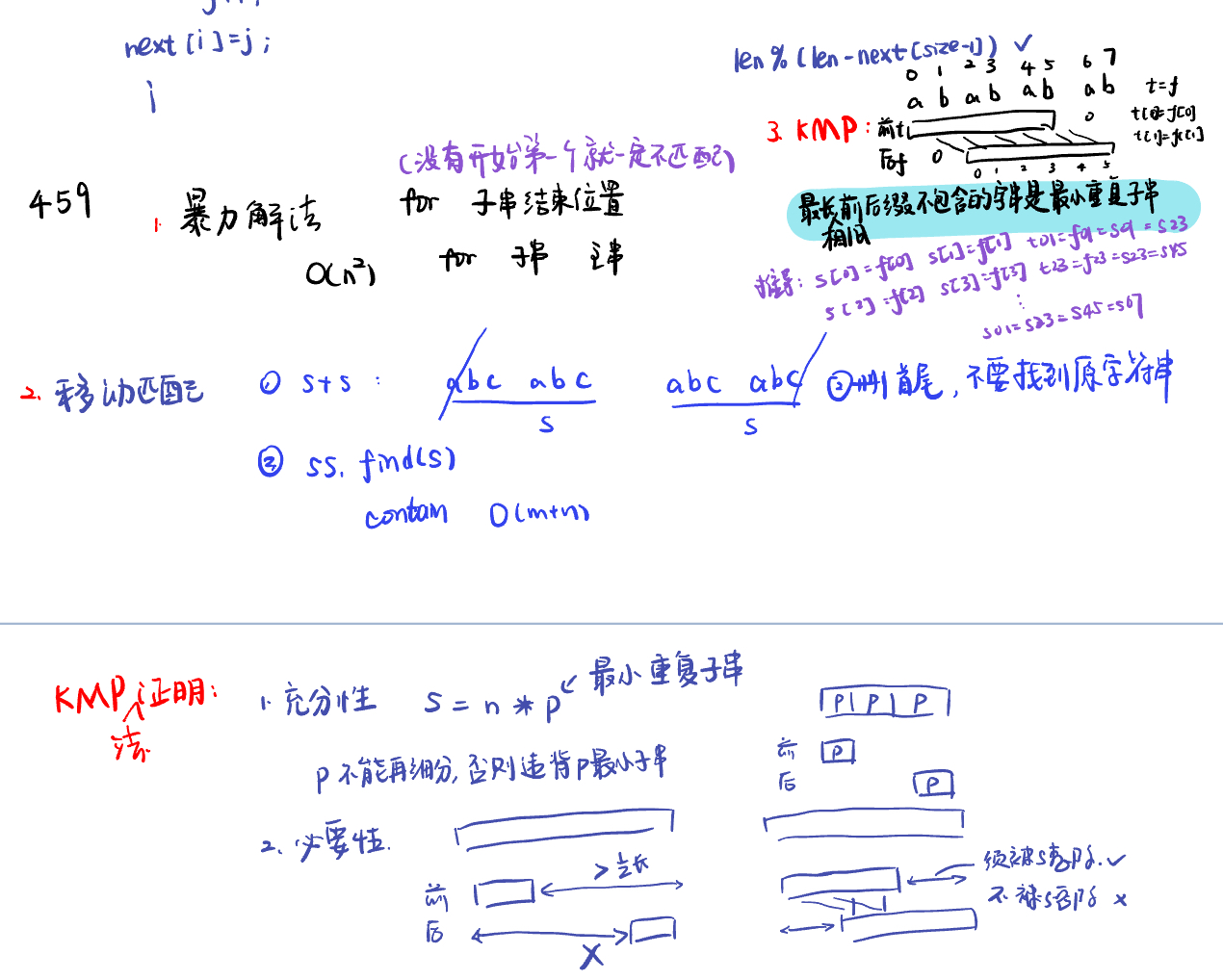SONG Shengjie
151.翻转字符串里的单词reverse-words-in-a-string,卡码网:55.右旋转字符串,28. 实现 strStr()find-the-index-of-the-first-occurrence-in-a-string,459.重复的子字符串repeated-substring-pattern,字符串总结,双指针总结
151.翻转字符串里的单词reverse-words-in-a-string

class Solution:
def reverse(self, s, start, end):
while start < end:
s[start], s[end] = s[end], s[start]
start += 1
end -= 1
def reverseWords(self, s: str) -> str:
result = ""
ss = list(s)
ss.reverse()
fast = 0
# 1. 首先将原字符串反转并且除掉空格, 并且加入到新的字符串当中
# 由于Python字符串的不可变性,因此只能转换为列表进行处理
while fast < len(ss):
if ss[fast] != " ":
if len(result) != 0:
result += " "
while fast < len(ss) and ss[fast] !=" ":
result += ss[fast]
fast += 1
else:
fast += 1
# 2.其次将每个单词进行翻转操作
slow = 0
fast = 0
result = list(result)
while fast <= len(result):
if fast == len(result) or result[fast] == " ":
self.reverse(result, slow, fast - 1)
slow = fast + 1
fast += 1
else:
fast += 1
return "".join(result)
卡码网:55.右旋转字符串

k = int(input())
s = input()
print(s[len(s) - k:]+s[:len(s) - k])
28. 实现 strStr()find-the-index-of-the-first-occurrence-in-a-string

class Solution:
def strStr(self, haystack: str, needle: str) -> int:
next = [0] * len(needle)
self.getNext(next, needle)
j = 0
for i in range(len(haystack)):
while j > 0 and haystack[i] != needle[j]:
j = next[j - 1] // j 寻找之前匹配的位置
if haystack[i] == needle[j]:
j += 1
if j == len(needle):
return i - j + 1
return -1
def getNext(self, next: List[int] , s: str) -> None:
j = 0
next[0] = 0
for i in range(1, len(s)):
while j > 0 and s[i] != s[j]:
j = next[j - 1]
if s[i] == s[j]:
j += 1
next[i] = j
459.重复的子字符串repeated-substring-pattern

- 暴力法:
class Solution:
def repeatedSubstringPattern(self, s: str) -> bool:
n = len(s)
if n <= 1:
return False
substr = ""
for i in range(1, n // 2 + 1): // 查一半:因为如果子字符串长度超过原字符串长度的一半,那么它重复后长度必然会超过原字符串,所以只需要检查长度不超过原字符串一半的子字符串即可
if n % i == 0 : //查整除:如果 n 不能被 i 整除,说明原字符串不可能由长度为 i 的子字符串重复构成
substr = s[:i] //提取字符串 s 的前 i 个字符作为子字符串 substr
if substr * (n // i) == s:
return True
return False
- 移动匹配
class Solution:
def repeatedSubstringPattern(self, s: str) -> bool:
n = len(s)
if n <= 1:
return False
ss = s + s # 将字符串 s 自身拼接一次
ss = ss[1:-1] # 去掉首尾元素
return s in ss
- KMP法
class Solution:
def repeatedSubstringPattern(self, s: str) -> bool:
next = [0] * len(s)
self.getNext(next, s)
if next[-1] != 0 and len(s) % (len(s) - next[-1]) == 0:
return True
return False
def getNext(self, next, s):
j = 0
next[0] = 0
for i in range(1, len(s)):
while j > 0 and s[i] != s[j]:
j = next[j - 1]
if s[i] == s[j]:
j += 1
next[i] = j
return next
字符串总结
-
反转系列:当需要固定规律一段一段去处理字符串的时候,要想想在在for循环的表达式上做做文章。先局部反转、再整体反转。
-
KMP算法:KMP的主要思想是当出现字符串不匹配时,可以知道一部分之前已经匹配的文本内容,可以利用这些信息避免从头再去做匹配了。主要理解j=next[x]
前缀表:起始位置到下标i之前(包括i)的子串中,有多大长度的相同前缀后缀。
前缀:指不包含最后一个字符的所有以第一个字符开头的连续子串。
后缀:指不包含第一个字符的所有以最后一个字符结尾的连续子串。
双指针总结
十道题目:移除元素、反转字符串、替换数字、翻转字符串里的单词、翻转链表、删除链表的倒数第N个节点、链表相交、环形链表Ⅱ、三数之和、四数之和。
一般是将O(n^2)的时间复杂度,降为 $O(n)$ 。
-
字符串:
-
反转字符串:定义两个指针(也可以说是索引下标),一个从字符串前面,一个从字符串后面,两个指针同时向中间移动,并交换元素。
-
替换空格:首先扩充数组到每个空格替换成”%20”之后的大小。然后双指针从后向前替换空格。其实很多数组(字符串)填充类的问题,都可以先预先给数组扩容带填充后的大小,然后在从后向前进行操作。
-
翻转字符串里的单词:使用双指针法,用O(n)的时间复杂度完成字符串删除类的操作。
-
链表:
-
反转链表:只需要改变链表的next指针的指向,直接将链表反转 ,而不用重新定义一个新的链表。
-
链表有环:使用快慢指针(双指针法),分别定义 fast 和 slow指针,从头结点出发,fast指针每次移动两个节点,slow指针每次移动一个节点,如果 fast 和 slow指针在途中相遇 ,说明这个链表有环。
-
N数之和:通过前后两个指针不断向中间逼近,在一个for循环下完成两个for循环的工作。